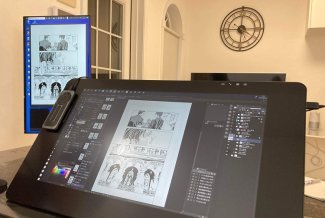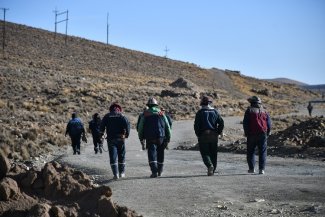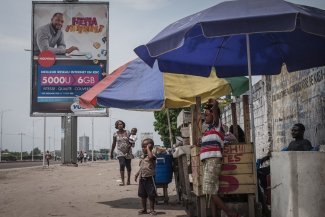Abdirehman Abdi, pictured here at the Kenya Methodist University campus in Nairobi, is one of 260,000 Somali refugees facing voluntarily repatriation from the Dadaab refugee complex by 2018.
University students Abdirehman Abdi and Sahro Mohamed Ibrahim first came to Kenya as refugees from Somalia in the early 1990s, and have spent most of their lives in Dadaab, the world’s biggest refugee complex in Garissa County in eastern Kenya. Today, they should be looking forward to a bright future, but uncertainty rules their lives as the closure of Dadaab looms ahead.
In November 2013, following a bloody terrorist attack on Nairobi’s Westgate Mall, the Foreign Ministries of Somalia and Kenya along with the United Nations High Commissioner for Refugees (UNHCR) agreed to facilitate the repatriation of all Somalia nationals living in Dadaab, citing Kenya’s concerns over national security.
Following the Garissa University attack in April 2015, in which al-Shabaab brutally killed 148 students, the government’s resolve to take action hardened. Kenya’s Deputy President William Ruto likened the atrocity to 9/11, while announcing that all remaining refugees in Dadaab would have to be repatriated by that September.
Although this deadline came and went, and the Kenyan government has since admitted it will be too difficult to evacuate the camps by November 2016 as later promised, the spectre of Dadaab’s closure still hangs over the remaining 260,00-odd Somali refugees living in its five camps.
Abdirehman, a 28-year-old third year computer science student at the Kenya Methodist University in Nairobi, moved to the camp as a five-year-old in 1991 – the year it was set up as a temporary solution to house 90,000 people fleeing civil war in Somalia. He completed his schooling in Dadaab before passing his exams to go to university.
“I have refugee relatives who resettled abroad who are paying for my university studies,” Abdi tells Equal Times. “My hope now is to get a job with an NGO in Somalia after my studies so that I can help my people back at home because the camp is being closed and the Kenyan government does not give us work permits to work here.”
Sahro, 26, is studying commerce at Kenyatta University in Nairobi. She says she is also planning to return to Somalia after she graduates because, as the country’s Interior Ministry spokesperson Mwenda Njoka explains, “Kenya’s refugee policy is to provide temporary stay for refugees and to let them go back home.”
In practical terms, this means that most refugees are only permitted to live in camps, unless they are seeking hospital treatment or pursuing further education. At present, it is almost impossible for a refugee to secure the legal right to work in Kenya.
“Now that the government is pushing to close Dadaab there is no other option for us other than to go back to Somalia,” says Sahro.
“Life in Somalia is very hard with the insecurity situation there. Dadaab is a peaceful place, a better home for the refugees than taking them back to Somalia.” But like Abdirehman, with her degree, Sahro hopes that she can be part of the generation that helps bring peace and stability to her country of origin.
Repatriations stalled
According to Duke Mwancha, a spokesperson for UNHCR Kenya, close to 25, 500 refugees have been voluntarily relocated to the 12 regions in Somalia since June 2016, where the Somali government, UNHCR and other NGOs, have been providing them with support.
Those who volunteer to return to Somalia are provided with bus transport back to an agreed destination along with a US$400 stipend. “UNHCR is also providing returnees with three months of food rations and assists children to attend school for at least six months,” says Mwancha.
“The target is to have 150, 000 refugees taken back home by the end of this year,” Mwancha tells Equal Times. The voluntary repatriation process, he says, is expected to end in 2018. Those who won’t go back, UNHCR has said, will be resettled in a third country, while non-Somali refugees will be rehoused at the Kakuma refugee camp in the north of the country.
In addition, there are an estimated 40,000 Kenyan citizens of Somali origin thought to be living in Dadaab (primarily because they receive free food rations, according to a report by the Danish Refugee Council).
Mwancha says that all efforts will be made to integrate those people into local communities. But some NGOs have said these repatriations are a violation of the 1951 Refugee Convention.
Refugees in Dadaab told Human Rights Watch (HRW) researchers that they had not been given information about how they could remain in Kenya legally.
Some also spoke of being intimidated and being told they would lose their right to a UN cash grant if they were deported rather than voluntarily repatriated.
“The Kenyan authorities are not giving Somali refugees a real choice between staying and leaving, and the UN refugee agency isn’t giving people accurate information about security conditions in Somalia,” said HRW refugee rights director Bill Frelick in a press statement. “There is no way these returns can be considered voluntary,” which goes against international law.
But government spokesperson Njoka refutes these accusations, telling Equal Times that the HRW report lacks the hard evidence to support its claims.
“As per the report, only 100 out of the almost 250,000 refuges in Dadaab were interviewed. This number is too low to come up with such conclusions,” he says.
“There is no single refugee that is being coerced to return home as the report indicates.”
Dadaab Voices
Together with other young people from Dadaab, Abdirehman and Sahro are part of a youth group called Dadaab Voices, which aims to connect residents to the outside world.
“The initiative started early this year. Our main aim is to tell Dadaab’s stories, mostly through Facebook and Twitter,” says Abdirehman. “A lot is happening in Dadaab now that is not being told because UNHCR and the other NGOs don’t want those stories told.”
He says issues range from the mistreatment of refugees by NGO staff to general insecurity to the significant downgrading of camps’ services and facilities (like running water) as the government prepares to close them down.
But as a priority, Dadaab Voices is trying to combat the misinformation being spread amongst camp residents about the repatriation process.
“For example, not everyone in the camp was aware of the population verification exercise [editor’s note: a census which established that there are 278,000 refugees in Dadaab, of which 95 per cent are Somalis who will be relocated back to Somalia] that was being conducted by UNHCR. Those who did not go for their verification have had their ration cards deactivated which is making it very hard for them to survive.”
Sahro said another problem is that when Dadaab residents do decide to go back to Somalia, UNHCR does not ask them to explain why.
Former residents complain of being given very little information on what they should expect back in Somalia and for Sahro, this is because the main aim is to increase the numbers of people being repatriated, even though in some cases, people find life back in Somalia so hard that they return to Dadaab.
But Abdi says the even though most refugees are afraid to return to Somalia, they are also afraid of being arrested and deported if they stay in Kenya. They reluctantly agree to go home because they consider this to be their only option.










